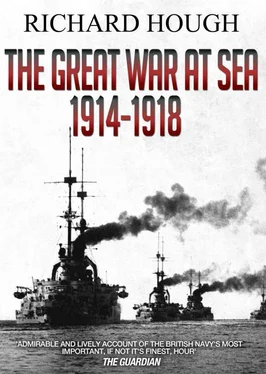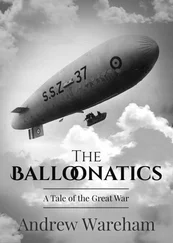It was this atmosphere of mutual distrust that this second conference was intended to reduce, but so choleric were Press comment and exchanges between the two nations’ statesmen before the delegates met, that expenditure on armaments was not even raised at the Hague. The only benefit to Britain stemming from the Hague Conference was a settlement of Anglo-Russian differences in Asia, which Germany regarded as the first stage leading to an alliance. This would leave Germany flanked on three sides by potential foes, increasing further her paranoia. Germany responded with an amendment to the 1900 Navy Law, which would effectively give the Kriegsmarine no fewer than fifty-eight dreadnoughts ten years hence.
The high summer of 1907 marked the sombre starting-point of the headlong gallop to war seven years later. There were efforts to draw in the reins and audible laments, not all of them hypocritical. But as far as naval armaments were concerned, and they were the dominating factor, both powers were now hell-bent on a race to conflict.
A counter-campaign in Britain against the new German increase called for ‘two keels to one’, a difficult target to achieve with a Liberal government dedicated to public welfare and the casing of the inequalities in the land. But as an indication of how deeply even the Liberal and Labour factions were involved in the nation’s naval preoccupation, the Manchester Guardian expounding the radical view accepted that naval rivalry with Germany was ‘rapidly becoming the principal outstanding question of European politics’ (3)and that Britain should certainly construct four new dreadnoughts a year to Germany’s three.
The Conservatives and the Conservative Press continued to be alarmed for the future. ‘Is Britain going to surrender her maritime supremacy to provide old-age pensions?’ was typical of the bellicose questions sounded out by the Daily Mail . Fisher’s enemies in and out of the Navy were now aroused to create a further contest within the Anglo-German contest by organizing a campaign for his removal. The faction’s idol and leader was Lord Charles Beresford, once a national hero, now elderly and bloated by extravagant living. An Irishman of aristocratic lineage and immense wealth, Beresford had once been Fisher’s ally in the reform movement in the Navy. But the two men, of equally volatile temperament and very different background, had fallen out, and the split had widened when Fisher was appointed First Sea Lord and was then promoted Admiral of the Fleet, ensuring the extension of his term of office to deprive Beresford of any prospect of succeeding him.
With its most important aim of ousting Fisher and replacing him with Beresford, an Imperial Maritime League was founded at the end of 1907. Lord Esher, whose support of Fisher was steady and whose influence was great in the land, gave to The Times a copy of the letter he wrote to the League defending Fisher. ‘There is not a man in Germany, from the Emperor downwards, who would not welcome the fall of Sir John Fisher,’ it concluded.
This letter led to the most bizarre incident in this Anglo-German naval rivalry. When it was shown to the Kaiser, he sat down and wrote in his own hand a letter nine pages long addressed to Lord Tweedmouth, political head of the Navy as First Lord of the Admiralty. In extravagant language, the Emperor of Germany stated that he was unable to understand British fears about the rise of the German Navy, which was not being created to challenge British naval supremacy. He also described Esher’s opinion that Germany would be glad to see Fisher out of office as ‘a piece of unmitigated balderdash’.
This new exercise in conducting Germany’s foreign policy caused amazement in Britain, and King Edward felt impelled to write his nephew a reprimand. The Times expressed outrage: ‘If there was any doubt before about the meaning of German naval expansion,’ it thundered, ‘none can remain after an attempt of this kind to influence the Minister responsible for our Navy in a direction favourable to German interests.’ (4)
In Germany, where the heavy warship building facilities were being expanded at high speed and at great cost, Anglophobia grew apace, too. Ever sensitive to being patronized, watchful for evidence of interference in national affairs, envious of the size and wealth of the British Empire, resentful of Britain’s apparent failure to regard Germany as a great power, anti-British feeling was easily whipped up by the Press, politicians, and the Emperor himself. ‘You English are mad, mad as March hares,’ he declared to an English newspaper correspondent, and made it clear that the great majority of his subjects were hostile to England. The well-informed and percipient British naval attaché in Berlin declared that he doubted now whether the Emperor, ‘much as he might desire it, could restrain his own people from attempting to wrest the command of the seas from Great Britain, if they saw a fairly good chance of doing so’. (5)
Fisher, always a target for sniping in the Royal Navy’s own internecine war, was also involved in the complex and anxious task of improving the efficiency of the service, protecting it from politicians of radical-Liberal persuasion, and observing from his own Whitehall based fighting top the threatening expansion of the German Navy.
Fisher had scored a second surprise moral victory over Germany by building and putting into service at great speed a new class of dreadnought-type armoured cruiser, bigger and faster than anything Tirpitz had contemplated, and with an all-big-gun armament twice that of any pre-dreadnought battleship. These formidable men o’war were what Fisher proclaimed to be his ‘New Testament ships’, ‘hares to catch tortoises’, scouting vessels of unprecedented speed (25+ knots) and power that could hunt down any warship anywhere in the world and sink it at leisure with its 12-inch guns. The battle-cruiser was to add a new element in the Anglo-German race, and by 1912 Germany had six built or building against Britain’s ten.
However exuberant and confident Fisher remained in the strength, numbers, and quality of the British fleets, information from his intelligence department revealed the rapid improvement in the seamanship and gunnery of the Kriegsmarine’s personnel and the excellent design of the first German dreadnoughts.
In 1909 there occurred the biggest peacetime naval crisis in British history, a ‘navy scare’ which made those of the late nineteenth century (when the French and Russians were the source of anxiety) seem trivial. Towards the end of 1908, when the mood of Germany was clearly more hostile than ever towards France as well as Britain, informed sources in London told of further German acceleration in dreadnought building. The speed of construction of heavy men o’war was conditioned by the months occupied in building the guns and gun mountings. Previously, German shipbuilders had shown that they could build a heavy ship in three years. Now, thanks to increased facilities at Krupp’s for building armour and guns and their mountings, this time had been reduced, it was believed, to little more than two years. Moreover, so rapid had been the increase in building slipways and training new men in the skills of shipbuilding, it was believed possible that Germany now had the capacity to build no fewer than eight dreadnoughts a year, equal to British capacity.
Statistics quoted to predict the size of the German battle fleets in 1912 or 1914, the speed of construction, and building capacity, all depended on inspired guesswork, and could be juggled to suit the needs of politicians, journalists, and naval officers. As Churchill wrote a few years later, ‘in the technical discussion of naval details there is such a wealth of facts that the point of the argument turns rather upon their selection than upon their substance. (6)But early in 1909 it was believed by Fisher and the Board that Germany would be able to put to sea a fleet of seventeen dreadnoughts by April 1912 against Britain’s eighteen: scarcely the two-keels-to-one standard previously regarded as minimal for the nation’s security.
Читать дальше












